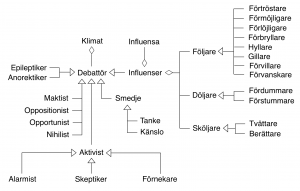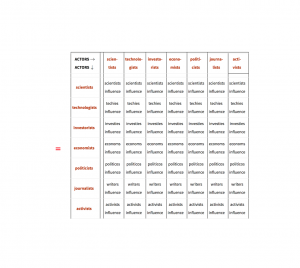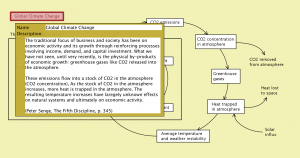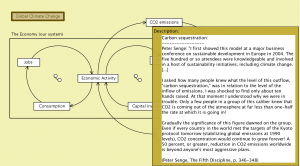This page is a sub-page of our page on Disagreement Management.
/////// Temporary formulas in Latex used for making powerpoints:
\, t_1 \, t_2 \, t_3 \,
\, h_1 \, h_2 \, h_3 \,
\, v_1 \, v_2 \, v_3 \,
\, i ( v_1 - v_2) + i ( v_2 - v_3) = i ( v_1 - v_3) \, .
Related KMR-pages:
• Physics and its Models
• Entropy
• The Decadence of Work, by Theodor Svedberg, 1915 (translated from Swedish)
• Social Algebra
• Social Calculus
• Modeling and Mapping
• Knowledge Negotiations
• David Hestenes on Modeling
• Provocative Modeling
Other relevant sources of information:
• Perspektiv på luftens koldioxidhalt
• Uncertainty in science and its role in climate policy, by Leonard A. Smith and Nicholas Stern, Philosophical Transactions of the Royal Society, A(2011) 369, 4818-4841, doi:10.1098/rsta.2011.0149
• Seeing through complexity: conflict, ideological change, environment and energy, innovation, new economics, societal growth and crisis, by Thomas Homer-Dixon.
• The Upside of Down – Catastrophy, Creativity, and the Renewal of Civilization by Thomas Homer-Dixon, review by Jennifer M. Rohleder, Sustainable Development Law & Policy, Vol. 7, Issue 2, Winter 2007.
• Complexity Science, by Thomas Homer-Dixon, Oxford leadership Journal, January 2011, Volume 2, Issue 1.
• Panarchy: Theory and Application, by Craig R. Allen, David G. Angeler, Ahjond S. Garmestani, Lance H. Gunderson, and C. S. Holling, the DigitalCommons@University of Nebraska – Lincoln.
• Synchronous failure: the emerging causal architecture of global crisis, by Thomas Homer-Dixon, Brian Walker, Reinette Biggs, Anne-Sophie Crépin, Carl Folke, Eric F. Lambin, Garry D. Peterson, Johan Rockström, Marten Scheffer, Will Steffen and Max Troell,
Ecology and Society 20(3):6, 2015.
• Human and nature dynamics (HANDY): Modeling inequality and use of resources in the collapse or sustainability of societies, by Safa Motesharrei, Jorge Rivas, Eugenia Kalnay, in Ecological Economics 101(2014), pp.90–102.
• Discrepancy in scientific authority and media visibility of climate change scientists and contrarians, Petersen, M., Vincent, E.M., Westerling, A.L., NATURE COMMUNICATIONS|(2019)10:3502.
• Changing Climate, Changing Minds, Guest post by David Siegel on WUWT, 14 March, 2020.
///////
Anchors into the text below:
• Debattklimatet i klimatdebatten
• The debate climate of the climate debate
///////
What follows is an embryo of a
Knowledge Base for a TYPOLOGY OF CLIMATE DEBATERS
Scientists:
• Satellite bulk tropospheric temperatures as a metric for climate sensitivity,
by John R. Christy and Richard T. McNider, Springer Link, 29 November 2017.
• Weak El Nino Conditions Help Explain Recent Global Warmth,
by Roy Spencer, January 13, 2020.
• 1D Model of Global SST Shows 40% of Warming Since 1979 Due to Early Volcanic Cooling,
by Roy Spencer, January 14, 2020.
• UAH Global Temperature Update for February 2020: +0.76 deg. C,
by Roy Spencer, 2 March 2020.
• Balloons in the Air: Understanding weather and climate, by Dr. Ronan Connolly & Dr. Michael Connolly, Center for Environmental Research and Earth Sciences, 16 Aug 2019.
• So if Angstrom already proved Arrhenius wrong, then what’s the problem?
at ClimateDebate.com
• Explainer: How do scientists measure global temperature, at www.carbonbrief.org, 2015.
• Trends in Atmospheric Carbon Dioxide – March 2019 – March 2020,
by Global Monitoring Laboratory, Earth System Research Laboratories, March 2020.
[Kan bli intressant för att belysa den alternativa hypotesen som säger att CO2 framförallt drivs av naturliga variationer i jordens klimat. T.ex. data från iskärnor som rätt konsekvent visar att uppvärmning kommer före ökad halt av CO2.]
• Presentation Prof. Murry Salby in Hamburg on 18 April 2013.
In Swedish:
• Falskt Alarm – Klimatfrågan ur vetenskaplig aspekt, på falsktalarm.se
• Ladda ner boken Falskt Alarm – Klimatfrågan ur vetenskaplig aspekt, av Gösta Pettersson, professor emeritus i biokemi vid Lunds Universitet.
• Falskt alarm om Falskt Alarm om Klimatet, kritik av boken Falskt Alarm av Maths Nilsson, författare.
• Gösta Pettersson svarar på kritiken från Maths Nilsson.
///////
Journalists:
In Swedish:
• Forskare nyanserar domedagsprofetian, av Gunnar Wetterberg, Expressen, 26 jan 2020.
Back to English:
Activists:
Alarmists:
• IPCC (Intergovernmental Panel on Climate Change)
• ‘The only uncertainty is how long we’ll last’: a worst case scenario for the climate in 2050, by Christiana Figueres and Tom Rivett-Carnac, 15 Febr 2020, the Guardian.
• Greta Thunberg’s speech at the Davos Meeting 2020.
• Climate Strikers: Open Letter to EU Leaders on why their new climate law is ‘surrender, 3 March 2020.
• Debunking Tony Heller’s ‘Gift to Climate Alarmists’, Mallen Baker on YouTube, 1 Oct 2019.
• Response to Tony Heller’s Why Climate Science is Broken, Mallen Baker on YouTube 12 Nov 2019.
• Silence the YouTube climate skeptics! | The Mallen Baker Show on YouTube, 17 Jan 2020.
In Swedish:
• Slutrapport_Bortom BNP, Göran Finnveden m.fl., KTH/Arkitektur, 29 dec 2019.
• Vad har hänt med den akademiska miljön?, av Per Welander, 17 jan 2020, Klimatupplysningen.se
In English:
Skeptics:
• NIPCC (Non-governmental International Panel on Climate Change)
• Fact Checking The Claim Of 97% Consensus On Anthropogenic Climate Change,
by Earl J. Richie, Forbes, 14 Dec 2016.
• The In-depth Story Behind a Climate Fraud, John Robson on YouTube,
Climate Discussion Nexus, 9 May 2019
• Hide The Decline: A Climategate Backgrounder, John Robson on YouTube,
Climate Discussion Nexus, 6 Dec 2019.
In Swedish:
• Klimatrealisterna – för en genomtänkt klimatpolitik,
Klimatupplysningen.se
• Kända politiker som är klimathotsskeptiker – del 1, av Per Welander, 3 jan 2020,
Klimatupplysningen.se
• Kända politiker som är klimathotsskeptiker – del 2, av Per Welander, 9 jan 2020,
Klimatupplysningen.se
• Klimatkarusellen, vilka frågor kan besvaras?, av Elsa Widding, 9 maj 2019,
Klimatupplysningen.se
///////
Debattklimatet i klimatdebatten: av Elsa Widding och Ingeman Arbnor
| Klimatdebattörstyper | Karaktäriseras av | Drivna av / Utgörs av |
| 1. Klimatextemister |
Klimatextremisterna tolkar all klimatinformation apokalyptiskt. |
Okunnighet, rädsla, medvetna eller omedvetna syften som gynnar personen eller organisationen ifråga. |
| 2. Klimatalarmister |
Klimatalarmisterna utgörs av personer eller organisationer som ofta, för egen räkning, har allt att vinna på en alarmerande klimatdebatt. Alla som inte Att nå målen |
Ofta utnyttjar klimatalarmisterna kimatextremisterna som “murbräcka” för sina egna syften. Denna grupp har ofta Bland de okunniga |
| 3. Klimatidealister |
Klimatidealisterna läser rapporterna från IPCC helt okritiskt, som den bästa vetenskapliga sanning som vi har tillgång till. Väljer att tolka alla osäkra data Inte sällan väljer man |
Klimatidealisterna kan vara väl pålästa och agerar därför inte extremistiskt eller alarmistiskt, men man hänvisar ofta till de beräkningar som IPCC utfört och till vad som anses nödvändigt att göra för att reducera de globala nettoutsläppen. Klimatidealisterna |
| 4. Klimatrealister |
Klimatrealisterna läser rapporterna från IPCC som den bästa vetenskapliga sanning som vi har tillgång till idag, men väljer att sätta sin tillit till IPCCs mest sannolika data – varken uppåt eller nedåt. Parisavtalets mål, 1,5 gradersmålet Problemet |
Globalt råder ju inte heller termisk jämvikt, eftersom atmosfären är varmare än haven, och havens temperatur kommer därför att stiga och avge koldioxid några decennier framåt. Dessutom Klimatrealisterna Man anser dessutom Klimatlagen är orimlig |
| 5. Klimatrationalister |
Klimatrationalisterna väljer att tolka alla osäkra data från IPCC på mildast tänkbara sätt inom de felgränser som IPCC anger. IPCCs nonchalans bidrar |
Klimatmodellernas projektioner kan därför inte tolkas som förutsägelser om en avlägsen framtid, utan måste ses som varninar för att obekymrat elda upp fossila reserver i närtid. Parisavtalets mål Klimatrationalister |
| 6. Klimatindifferenter = Klimatexploatörer |
Klimatindifferenterna bryr sig inte om IPCC men anammar den politiska retoriken om att vi befinner oss i en klimatkris, dvs man accepterar den politiska viljan att Sverige ska bli fossilfritt och leva upp till målen i Parisavtalet utan att närmare fundera över konsekvenserna. |
I gruppen av klimatindifferenter finns det väldigt många som passar in. Den här gruppen Klimatindifferenterna Så en annan Här skulle t.ex. Vattenfall Det handlar till stor del |
| 7. Klimatignoranter |
Klimatignoranterna avfärdar klimatdebatten med att IPCC har fått det mesta om bakfoten, och att den forskning som IPCC väljer ut för sin sammanställning av kunskapsläget till stora delar handlar om politik. Det finns en skepsis |
Klimatignoranterna har ofta egna bloggar, där det argumenteras för att uppvärmningen av atmosfären inte alls påverkas av dess koldoixidhalt, utan har helt andra orsaker. Klimatignoranterna Så här finns |
Sedan har vi klimatrealisterna och klimatrationalisterna som argumentar för att andra problem i samhället är viktigare än att snabbt försöka minska utsläppen av koldioxid i atmosfären, eftersom klimatet inte förändras i den snabba takt som de tre första grupperna anser. De konsekvenser av klimatförändringarna som diskuteras i media har normalt inte någon koppling till den ökande halten av koldioxid i atmosfären, utan man diskuterar en massa saker som egentligen är ganska ovidkommande.
Klimatrealisterna och klimatrationalisterna anser att vi bör prioritera världens resurser på ett bättre och mer kostnads- och klimateffektivt sätt och fokusera på det som är viktigare för mänskligheten än att på kort sikt minska fossilberoendet. Inom de här två grupperna refererar man ofta till data från det stora vetenskapliga arbetet på flera tusen sidor som IPCC sammanställer, AR6 alltså. Och det är inom de här två grupperna som det pågår en vetenskapsbaserad kritik av både IPCC och den politiserade klimatdebatten som sådan.
Klimatindifferenterna funderar inte på vad som är rätt eller fel i den vetenskapliga diskussionen runt klimatet – det kanske är för svårt för dem, eller för jobbigt, eller också så saknar man bara intresse och det rätta engagemanget – och inte sällan så väljer man att anamma det synsätt som är mest politiskt korrekt och mest gynnsamt för den privata karriärsutvecklingen. Eller så struntar man helt i ämnet, liksom i att delta i någon form av klimatdebatt överhuvudtaget.
Och sist, klimatignoranterna, som anser att själva den vetenskapliga grunden för klimatdebatten är felaktig. Man kritiserar inte bara diverse antaganden som IPCC gör utan anser att hela IPCC närmast är att likna vid en bluff.
///////
• SD: Ohållbar situation för energisystemet, Svenska Dagbladet, 13 Juni 2022.
• Varför jag väljer politiken, av Elsa Widding på YouTube, 1 Maj 2022.
• Står vi inför en global lågkonjunktur?, Magnus Henrekson och Jan Blomgren intervievas av Marco Strömberg på Hotspot, 12 Mars 2022.
• Så blev Sverige en koloni för energi, Jan Blomgren på Ledarsidorna.se, 6 Juli 2022.
• Är Sverige en koloni för energi?, Elsa Widding #63 på Klimatkarusellen , 8 Juli 2022.
• Vad kostar vindkraften – egentligen?, Jan Blomgren på Ledarsidorna.se, 9 Juli 2022
• VIND-LÖGNER: Vindkraftens Verkliga Kostnader, Henrik Jönsson på YouTube, 9 Juli 2022.
• Stoppa slöseriet på helt orealistiska projekt, Björn Törnvall på Ledarsidorna.se, 1 Juli 2022.
• Nu anmäler jag SVT, av Elsa Widding på YouTube, 30 Oct 2021
Transcribed into English.
• Klimatkarusellen: Elsa Widdings kanal på YouTube, april 2020.
• Högt spel i Davos, av Jacob Nordangård, 4 febr 2020,
Klimatupplysningen.se
• Halvseriöst om klimatet, av Gunnar Carlsson på Acta Catastrophica
In English:
///////
The debate climate of the climate debate: (in Swedish) by Elsa Widding and Ingeman Arbnor
| Debating types | Characterised by | Driven by / Consist of |
| 1. Climate extemists |
Climate extemists interpret all climate information apocalyptically. |
Ignorance, fear, conscious or unconscious forces that benefit the person or organisation in question. |
| 2. Climate alarmists |
Climate alarmists are persons or organizations that often have everything to gain from an alarming climate debate. Everybody who does not accept their extremism is described as a “climate denialist” since s/he denies that the world is facing an unavoidable catastrophy. Within this group |
The climate alarmists often make use of the climate extremists as “proxies” for their own purposes. This group often has Among the ignorant Among the more knowledgable |
| 3. Climate idealists |
Climate idealists read the reports from the IPCC in a totally uncritical way, as the best scientific truth that we have available. Climate idealists Climate idealists |
Climate idealists can be well informed and therefore they don’t act extremistically or alarmistically, but they often refer to the calculations that the IPCC has carried out and to what is considered necessary in order to reduce the global netto emissions. Climate idealists |
| 4. Climate realists |
Climate realists read the reports from the IPCC as the best scientific truth that we have at our disposal today, but they choose to rely on the most probable data that the IPCC provides – neither uppward or downward in probability. The aim of the Paris agreement, The 1.5 degree goal The problem |
Globally there is no thermodynamic equilibrium, since the atmosphere is warmer that the oceans. Therefore the temperature Moreover Climate realists Climate realists also consider The Swedish Climate Law |
| 5. Climate rationalists |
Climate rationalists choose to interpret all uncertain data from the IPCC in the most beneficial way within the error boundaries that the IPCC provides. According to the climate rationalists, |
The projections of the climate models should therefore not be interpreted as predictions about a distant future , but should instead be interpreted as as warnings against the light-hearted burning of fossile reserves in the near future. The aims of the Paris agreement Climate rationalists |
| 6. Climate indifferents = Climate exploiters |
Climate indifferents do not care about the IPCC but align themselves with the political rhetoric that we are in a climate crisis, that is, they accept the political will that Sweden should become fossile-free and should live up to the aims of the Paris agreement without thinking through the consequences. |
In the group of climate indifferents there are very many that fit in well. The members of this group However, So another suitable label The Swedish electricity provider The climate indifferents |
| 7. Climate ignorants |
Climate ignorants dismiss the climate debate by claiming that the IPCC has got most things wrong, and that the research that the IPCC selects for its presentations of the knowledge state of climate research in most parts is based on poitics. There is a skeptic attitude |
Climate ignorants often have their own blogs, where they argue that the warming of the atmosphere is not caused by its increase of carbon dioxide but has entirely different causes. Climate ignorants So here there is |
The we have the climate realists and the climate rationalists that argue that other problems in society are more important than trying to diminish the emission of carbon dioxide to the atmosphere as fast as possible, since the climate is not changing as fast as the first three groups claim. The consequences of climate change that are discussed in mainstream media normally has no connection to the increasing amount of carbon dioxide in the atmosphere, and the journalists are discussing a lot of issues, that in fact are rather irrelevant.
The climate realists and the climate rationalists think that we should prioritize the world’s resources in a better and more cost- and climate-effective way. We should focus on that which is more important for humanity that a super-rapid diminishing of our dependence on fossile fuel. Within these two groups one often refers to data from the large scientific study of several thousand pages that is orchestrated by the IPCC that is , AR6. And it is within these two groups that the scientific critisism of both IPCC and the highly politicised debate can be found.
The climate indifferents are not thinking about what is correct respectively incorrect in the scientific discussion of climate change. This may be because this may be too difficult for them, or it may be because the people in this group simply lack the interest and the proper engagement. Instead they choose to adopt the opinions that are most politically correct and therefore most beneficial for the development of their personal careers. Or they simply choose to ignore the subject and not take part in the climate debate at all.
And finally, the climate ignorants, claim that the scientifc basis for the climate debate is incorrect. People in this group critizise not only some of the assumptions made by the IPCC but consider the IPCC itself to be somewhat of a scam.
///////
• Maldives To Drown Again, Pulling Back The Curtain on Junk Science,
by Tony Heller, 17 Jan 2020.
• Arctic Sea Ice Refuses To Melt As Ordered, by Tony Heller, on YouTube, 30 Jan 2020.
• Real Climate Science, Tony Heller’s blog.
• A Century of US Cooling – Erased by NOAA, by Tony Heller on YouTube, 20 Dec 2017.
• Climate.etc, by Judith Curry.
• The toxic rhetoric of climate change, by Judith Curry, December 14, 2019.
• A Climate Blacklist That Works: “It Should Make Her Unhirable In Academia”,
by Roger Pielke at Forbes.com 9 Febr 2020.
Denialists:
• Climate Change with Lord Monckton, YouTube August 9, 2018.
• Viscount Christopher Monckton Speech – Climate Change: Debunking the Myths, YouTube October 9, 2019.
• Global warming on trial and the elementary error of physics that caused the global warming scare by Christopher Monckton of Brenchley, March 19, 2018.
• Roy Spencer’s response to Lord Mochton’s article, March 22, 2018.
• Lord Monchton’s response to Roy Spencer’s response, March 23, 2018.
///////
In Swedish:
Typologi (= ontologi) av av klimatdebattörer (version 1):
///////
In English:
The Climate Debate: Disagreement Management Through Knowledge Algebra:
Knowledge algebra is a matrix-based mathematical framework that enables dynamic overview of the model that you are developing (or executing) as well as combinatorial control over the options from which the successive choices are made.
Modeling in KA consists of constructing knowlecules, which represent separate chunks or ‘molecules’ of encoded knowledge or behaviour. A knowlecule is a type of matrix (specifically a named adjacency matrix). The thing whose name or description appears in the position \, [i, k] \, of this matrix indicates that there is a relationship between the things whose names appear in row \, i \, and column \, k .
Being matrices, knowlecules can be combined in various ways according to the rules of matrix algebra. Since the things behind the names can be anything, anything that can be named can be modeled. This includes all chains of (possibly) relevant relations between all parameters that have been introduced in the model. Moreover, such relational chains can be evaluated both contextually and symbolically, allowing each symbol of a formal computation to change its relevance dynamically – by being connected to context-specific evaluations that bring in dynamic information from the outside. This feature of emerging relevance is at the heart of knowledge algebra. A good illustration of the power of this way of modeling is provided by the Ericsson AXE10 delay.
Business algebra is an application of knowledge algebra to the business domain. Business algebra was developed within the EU/IST/FP7 project TELL ME, and is described in detail in the report Business Algebra: A Mathematical Framework for Business Process Modeling,
[TELL ME D.1.3-Annex(v2)].
///////
How actors influence each other through their models, reports and summaries
(work in progress):
Actors –> processes –> Products:
\, \langle \, A_{ctors} \, \vert \, \vert \, P_{roducts} \, \rangle \, =| PRODUCTS \rightarrow ACTORS \, \downarrow \, |
models | reports | summaries | |
| scientists | scientists modeling | scientists reporting | scientists summarizing | |
| technologists | technologists modeling | technologists reporting | technologists summarizing | |
| investorists | investorists modeling | investorists reporting | investorists summarizing | |
| economists | economists modeling | economists reporting | economists summarizing | |
| politicists | politicists modeling | politicists reporting | politicists summarizing | |
| journalists | journalists modeling | journalists reporting | journalists summarizing | |
| activists | activists modeling | activists reporting | activists summarizing |
///////
Products –> influence –> Actors (work in progress):
\, \langle \, P_{roducts} \, \vert \, \vert \, A_{ctors} \, \rangle \, =| ACTORS \rightarrow PRODUCTS \, \downarrow \, |
scien- tists |
technolo- gists |
investo- rists |
econo- mists |
politi- cists |
journa- lists |
acti- vists |
|
| models | models influence |
models influence |
models influence |
models influence |
models influence |
models influence |
models influence |
|
| reports | reports influence |
reports influence |
reports influence |
reports influence |
reports influence |
reports influence |
reports influence |
|
| summaries | sums influence |
sums influence |
sums influence |
sums influence |
sums influence |
sums influence |
sums influence |
///////
Actors –> influence –> Actors (work in progress):
\, \langle \, A_{ctors} \, \vert \, \vert \, P_{roducts} \, \rangle \, \times \, \langle \, P_{roducts} \, \vert \, \vert \, A_{ctors} \, \rangle \, = \, \langle \, A_{ctors} \, \vert \, \vert \, A_{ctors} \, \rangle \, =| ACTORS \rightarrow ACTORS \, \downarrow \, |
scien- tists |
technolo- gists |
investo- rists |
econo- mists |
politi- cists |
journa- lists |
acti- vists |
|
| scientists | scientists influence |
scientists influence |
scientists influence |
scientists influence |
scientists influence |
scientists influence |
scientists influence |
|
| technologists | techies influence |
techies influence |
techies influence |
techies influence |
techies influence |
techies influence |
techies influence |
|
| investorists | investies influence |
investies influence |
investies influence |
investies influence |
investies influence |
investies influence |
investies influence |
|
| economists | economs influence |
economs influence |
economs influence |
economs influence |
economs influence |
economs influence |
economs influence |
|
| politicists | politicos influence |
politicos influence |
politicos influence |
politicos influence |
politicos influence |
politicos influence |
politicos influence |
|
| journalists | writers influence |
writers influence |
writers influence |
writers influence |
writers influence |
writers influence |
writers influence |
|
| activists | activists influence |
activists influence |
activists influence |
activists influence |
activists influence |
activists influence |
activists influence |
///////
///////
Refining the ‘activist’ type by introducing ‘alarmist’, ‘scepticist’, and ‘denialist’ (work in progress):
///////
Peter Senge on Global Climate Change:
Source: The Fifth Discipline: The Art & Practice of the Learning Organization,
by Peter Senge (2006(1990), p. 345), ISBN 0-385-51725-4.
///////
DISAGREEMENT MAP ON CLIMATE CHANGE
(work in progress):
Conzilla original: http://conzilla.org/users/amb/project/disagreementManagement/layout/contextmap#547d566417366c8149f
Some screendumps:
Climate Alarmists, Researchers, Skeptics (v4)
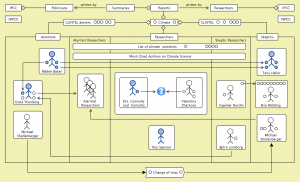
///////
Climate Alarmists, Researchers, Skeptics
CLINTEL = Climate Intelligence:
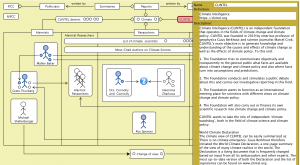
///////
Climate Alarmists, Researchers, Skeptics
The CLINTEL scientific manifesto:
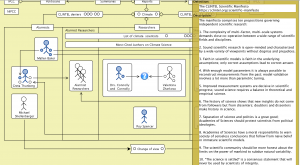
///////
Climate Alarmists, Researchers, Skeptics
CLINTEL: there is no climate emergency:

///////
Climate Alarmists, Researchers, Skeptics
CLINTEL: open letter to the KNAW – part 1:
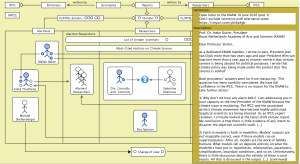
Climate Alarmists, Researchers, Skeptics
CLINTEL: open letter to the KNAW – part 2:
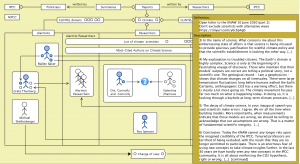
Climate Alarmists, Researchers, Skeptics
CLINTEL open letter to the KNAW – part 3:
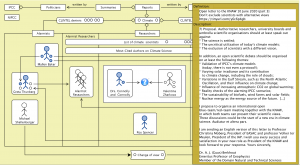
///////
CLINTEL deniers
Climate Science Deniers Planning European Misinformation Campaign:

///////
CLINTEL deniers
Letter signed by “500 scientists” relies on inaccurate claims about climate science:

///////
CLINTEL deniers
DESMOG: Clearing the PR Pollution that clouds climate:
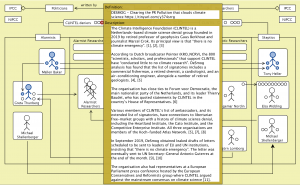
///////
Climate Alarmists, Researchers, Skeptics
Connolly and Connolly: Balloons in the air – Understanding Weather and Climate (YouTube):

///////
Professor Valentina Zharkova
CONFIRMS “super” grand solar minimum (on Youtube):
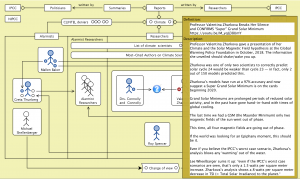
///////
Valentina Zharkova’s Double Dynamo
Double layers in the turbulent surface layer of the Sun:

Dipole potential surface
(Math Rehab on YouTube):
The Latest on the Double-Dynamo Solar Model
and Dr. Zharkova’s Predictions of a Grand Minimum:

Quadrupole potential surface
(Math Rehab on YouTube):
///////
/////// Quoting Smith and Stern: Uncertainty in science and its role in climate policy
Abstract:
Policy-making is usually about risk management. Thus, the handling of uncertainty in science is central to its support of sound policy-making. There is value in scientists engaging in a deep conversation with policy-makers and others, not merely ‘delivering’ results or analyses and then playing no further role. Communicating the policy relevance of different varieties of uncertainty, including imprecision, ambiguity, intractability and indeterminism, is an important part of this conversation. Uncertainty is handled better when scientists engage with policy-makers.
Climate policy aims both to alter future risks (particularly via mitigation) and to take account of and respond to relevant remaining risks (via adaptation) in the complex causal chain that begins and ends with individuals. Policy-making profits from learning how to shift the distribution of risks towards less dangerous impacts, even if the probability of events remains uncertain. Immediate value lies not only in communicating how risks may change with time and how those risks may be changed by action, but also in projecting how our understanding of those risks may improve with time (via science) and how our ability to influence them may advance (via technology and policy design).
Guidance on the most urgent places to gather information and realistic estimates of when to expect more informative answers is of immediate value, as are plausible estimates of the risk of delaying action. Risk assessment requires grappling with probability and ambiguity (uncertainty in the Knightian sense) and assessing the ethical, logical, philosophical and economic underpinnings of whether a target of ‘50 per cent chance of remaining under +2◦C’ is either ‘right’ or ‘safe’. How do we better stimulate advances in the difficult analytical and philosophical questions while maintaining foundational scientific work advancing our understanding of the phenomena? And provide immediate help with decisions that must be made now?
1. Introduction
[…]
Writing in 1921, Knight [3] noted that economics ‘is the only one of the social sciences which has aspired to the distinction of an exact science . . . it secures a moderate degree of exactness only at the cost of much greater unreality’. A similar competition between exactness and unreality is present in climate science, where differences between our models of the world and the world itself lead to situations where we cannot usefully place probabilities on outcomes (ambiguity) alongside situations where we can place probabilities on outcomes (imprecision) even if we cannot determine the outcome precisely.
Specific scientific details in the ‘unreality’ of current climate models led Held [4] to note that in the future ‘today’s global warming simulations will be of historical interest only’. This statement itself may be of value to policy-making by stifling overconfidence in the details of today’s model output. It does not imply that climate science is of no value in supporting climate policy today, as climate science provides a basis for risk management much deeper and firmer than the latest simulation model. Models can increase our understanding long before they start providing realistic numbers. Sound policy- making can profit from a clear and lively discussion of what we know, what we do not know and what we are likely to soon know significantly better than we know now.
The fact that uncertainties are large cannot be taken to imply that the risks are small, or that policy-makers can act as if the risks were small. Both the magnitude of plausible impacts and the cost of delayed action figure into the risk-management framework, making the claim ‘uncertainty in the future climate justifies acting as if the risks were small’ completely untenable. Uncertainty in the face of plausible risks can be argued to support immediate action. In a risk-management framework, scientists propose both the physical mechanisms supporting a view and an estimate of the probability that that view is, in fact, incorrect; ideally suggesting some decisive observations to distinguish their position from the alternatives [5]. Focusing applied scientific research on the reduction of risk and public debate on the point at which current science enters ambiguity sidesteps an endless discussion of establishing certainty. In any case, certainty is not on offer for the particular applications being discussed here. Arguably, certainty is an aim even well beyond the goals of science.
[…]
2. Distinguishing some varieties of uncertainty
Writing in 1862 about the provision of information regarding the likely weather, FitzRoy [6] stressed, ‘When in doubt, distrusting indications, or inferences from them, the words “Uncertain”, or “Doubtful”, may be used, without hesitation’ (italics in the original). While doubt remains the active state of the working scientist, the public communication of the scepticism scientists hold regarding various details of the science of the day is often surprisingly constrained and confused. In part, this comes from different scientists using common words to mean very different things. Policy-making is often focused on cases where there is confidence that major changes are likely to occur, while there is very limited ability to quantify the impacts of those changes for people. There are at least four relevant varieties of uncertainty in this case (see also Granger-Morgan et al. [7], Petersen [8] and Berliner [9] and references therein), and they are not mutually exclusive: imprecision, ambiguity, intractability and indeterminacy.
— Imprecision (Knightian risk, conditional probability): related to outcomes which we do not know precisely, but for which we believe robust, decision- relevant probability statements can be provided. This is also called ‘statistical uncertainty’ [10–12].
— Ambiguity (Knightian uncertainty): related to outcomes (be they known, unknown or disputed), for which we are not in a position to make probability statements.1 Elsewhere called ‘recognized ignorance’ [11,12] and ‘scenario uncertainty’ [10]. Ambiguity sometimes reflects uncertainty in an estimated probability, and is then referred to as ‘second-order uncertainty’.
— Intractability: related to computations known to be relevant to an outcome, but lying beyond the current mathematical or computational capacity to formulate or to execute faithfully; also to situations where we are unable to formulate the relevant computations.
— Indeterminacy: related to quantities relevant to policy-making for which no precise value exists. This applies, for instance, with respect to a model parameter that does not correspond to an actual physical quantity. It can also arise from the honest diversity of views among people, regarding the desirability of obtaining or avoiding a given outcome. Noting indeterminacy reminds us of the difference between a situation where no fact of the matter exists from the case in which there is a fact of the matter but it is not known precisely.
[…]
3. The causal chain and sound climate policy
[…]
The perceived risks to individuals in the present and the future drive current policy to design and deploy changes to the emission pathway, changes which aim for a more desirable outcome for individuals and societies. Poor handling of uncertainty by science can lead to less effective policy-making. Specifically, encouraging overconfidence in the realism of today’s best available simulation or intentionally portraying ambiguity incorrectly as if it was imprecision could lead to undesirable outcomes for individuals and societies, outcomes which could have been avoided by better-informed policy-making today.
Alternatively, scientific reflection aided by a realistic analysis of model output can indicate which actions are most likely to reduce the likelihood of undesirable events even amidst imprecision, ambiguity, intractability and indeterminacy. Improving the manner in which science handles uncertainty can aid policy-making in its attempt to shift unspecified ‘probability distributions’ towards more acceptable outcomes.
It is weather that impacts individuals. Early definitions of ‘climate’ recognize this; climate reflects the impacts on individuals when it is considered to be the statistical collective of weather however expressed [25]. Under this definition, changes in climate are of direct policy relevance. Modern definitions of climate tend to discuss average weather, say monthly means, and how these average values change in time [26]. Defined in this way, climate does not translate into impacts: in particular, short-lived extreme events [27] are excluded by the definition. This is a result of the simple fact that weather defines the climate, whereas climate, if defined as averages, does not define the weather. And it is weather that impacts individuals.
[…]
6. Ambiguity and insight in science
The knowledge base in climate science is much deeper than the latest, most complicated climate model, even if the headlines perpetually focus on the latest model runs. The science base as a whole suggests that the risks of significant impacts of increasing greenhouse gas concentrations are large. There are many models, and the latest model takes its place in this hierarchy [4,36,37]. Thus far, each level of the hierarchy confirms that the risk of significant negative impacts is large. Detailed impacts are not certain, but this uncertainty does not suggest a scientific argument that the risks are small. Incorporating scientific uncertainty into policy can reduce negative impacts due either to an ignorance of uncertainty or to the misuse of a good knowledge of uncertainty.
In an early paper on simulating the effect of doubling the concentration of carbon dioxide in a climate model, Manabe & Wetheral [38] noted that ‘because of the various simplifications of the model described above, it is not advisable to take too seriously the quantitative aspect of the results obtained in this study’. They then go on to state that their aim was to understand the processes involved, and in that aim they had some success. Their warning against taking quantitative model outputs too seriously still stands today, although our understanding of the climate system has increased significantly in the 35 years since that warning was issued, and models have played a role in advancing that understanding.
One can still argue that our climate models are more useful in increasing our understanding and insight than providing detailed numbers suitable for forward planning; this argument becomes stronger in the second half of this century and beyond. Scientific understanding of the mechanisms of the climate system and their likely responses reinforce the view that the risks are significant and that a delay in action can be very costly.
[…]
Given that (i) model diversity need not constrain (anyone’s) sub jective probability of events in the world, (ii) climate simulations hold a high- profile position relative to the foundational climate science, and (iii) today’s models are not empirically adequate even in simulating today’s climate, the drive to extract precise probability projections of very high spatial resolution (http://ukclimatepro jections.defra.gov.uk/content/view/868/531/) might be found surprising. The astonishing success of computer simulation at providing useful, if far from perfect, probability forecasts for weather phenomena is reminiscent of how the Newtonian framework first advanced and later retarded the advance of scientific understanding.
Whitehead [44] referred to the mis-identification of model-based entities with their real-world counterparts as the fallacy of misplaced concreteness, writing: ‘The advantage of confining attention to a definite group of abstractions is that you confine your thoughts to clear-cut definite things, with clear-cut definite relations. …The disadvantage of exclusive attention to a group of abstractions, however well-founded, is that, by the nature of the case, you have abstracted from the remainder of things. …Sometimes it happens that the service rendered by philosophy is entirely obscured by the astonishing success of a scheme of abstractions in expressing the dominant interests of an epoch’.
Computer simulations have achieved astonishing success in weather forecasting. Advances in computational graphic arts and statistical post-processing can create an attractive picture from simulations of an empirically inadequate model. Arguably, the policy-relevant aim of today’s climate simulation is neither numbers nor pictures but insight. To interpret model-based probabilities for climate at the end of this century as reflecting some aspect of the world is to commit Whitehead’s fallacy of misplaced concreteness.
[…]
7. Improving the support science provides climate policy-making
Communication is most effective when scientists carefully consider the processes and levers of policy-making. Without careful communication, policy-makers do not know how to use what they are hearing. Communicating all varieties of uncertainty allows policy-makers to more easily hear early warnings for initiating policy action and more confidently ignore late excuses for delaying action further still. The case against action has to successfully argue that the risks are small, not merely that the outcomes are uncertain. Engaging with the policy process and communicating the current level (and limits) of scientific understanding will lead to more effective policy-making than merely providing clear statements of state of the science in terms familiar to the scientists themselves.
Along with other policy targets which persist for decades if not centuries, the need for scientific support for climate policy will be with us on time scales longer than the professional career of any particular scientist. How do we better stimulate and harvest advances in deep and difficult research questions while maintaining foundational work advancing our understanding of the phenomena [45]? How can we maintain and enhance the ways in which science handles uncertainty in all its forms, so as to improve the support science offers to climate policy-makers? Significant engagement with these questions lies beyond the scope of this paper. Nevertheless, there is some value in opening a discussion of these and related questions.
Even as simulations improve, the need to evaluate ambiguity and intractability implies a need for scientific understanding of the Earth System that surpasses the ability to build (a component of) a good simulation. A level of understanding of the entire physical system is of value here: understanding that allows both insight into the system itself and recognition of the limits of state-of-the-art simulations.
Current incentives in science tend to drive the rising generation of young scientists towards specialization. How would the guidance we offer our graduate students change (or the content of our lecture courses), if the aim were to improve the state of climate science in 2030, rather than to secure them a career path in 3 years’ time? Since scientists are human beings, the policy relevance of their work, its limitations and its oversell are affected by incentives on the table.
Current incentives for research programmes are not tuned to benefit policy support in the long run. A solid piece of important mathematics or physical analysis that advances our understanding, but is of little immediate practical value, may prove of less value in securing a research position than the development and first implementation of some parametrization scheme for some ‘penguin effect’-like phenomenon.* Do current incentives focus researchers appropriately on the foundational work which will prove of most value to policy-makers in the long run?
=============
* The penguin effect occurs when penguins, which have black backs and white bellies, react to the local warming and roll over, altering the Earth’s albedo. The effect is apocryphal, and were it to exist current models do not realistically simulate the conditions that would drive it. Nevertheless, were a young researcher to implement this effect in one state-of-the-art climate model, he or she would be all but assured employment doing the same at a competing institution.
=============
[…]
Arguably, science aims at understanding the phenomena, ideally banishing ambiguity to a negligible role and reducing prediction to the propagation of current imprecision into the future. To oversimplify: advances in pure science reduce ambiguity and clarify questions of intractability, while advances in applied science and simulation increase the relevance of our conditional probabilities for decision-making by quantifying imprecision better. Policy support with regard to long-lived phenomena like climate change will be less effective if either area is neglected.
8. Concluding remarks
Sound policy-making embraces the causal chain connecting actions by people to impacts on people. Many varieties of uncertainty are encountered along this chain, including: imprecision, ambiguity, intractability and indeterminacy. Science regularly handles the first with probability theory; ambiguity and intractability are more often used by scientists to guide the advancement of science rather than being handled within science explicitly [45]. A better understanding by scientists of the roles of uncertainty within policy-making may improve the support science offers policy-making. In particular, an improved understanding of which scientific uncertainties pose the greatest challenges to policy-making when projected along the entire causal chain considered by policy, and informed scientific speculation on the likelihood of reducing those specific uncertainties in the near future, would be of immediate value. Some of these roles have been illustrated in the context of a particular example: selecting a stabilization target for greenhouse gas concentration.
Handling ambiguity in science, and the communication of insights from science, has been discussed. The value of scientific insight to policy-making, particularly in cases where state-of-the-art models are not empirically adequate, is stressed. Specifying the robustness of insights, and ideally quantifying how quickly model simulations are likely to become mis-informative as one moves further into the future, are each of significant value to sound policy-making.
No scientific extrapolation is complete without a quantitative estimate of the chance of its own irrelevance. Communicating to policy-makers the level of confidence scientists have that their model-based probabilities are not mis-informative is at least as important as communicating the model-based probabilities themselves. Engagement of scientists in the policy-making process, not merely by presenting the outputs of models but by explaining the insights from science, can significantly improve the formation of policy. This is especially true in climate policy, where the scale of the risk is great even if we cannot provide precise probabilities of specific events, and where many plausible changes are effectively irreversible should they occur.
Scientists who merely communicate results within the comfortable area of reliable theory abandon the decision stage to those who often have little engagement with the science. Sound policy-making is then hindered by the lack of sound scientific speculation on high-impact events, which we cannot currently model but may plausibly experience. Failing to engage with the question ‘What might a 6 °C warmer world look like, if it were to occur?’ leaves only naive answers on the table for policy-makers to work with.
Complementary to the need for scientific engagement with the policy process is the need for more transparent communication of the limits of current models when presenting model output. Policy-makers are often told that the models ‘have improved’ and that representations of more phenomena ‘have been introduced’. Clear statements of the spatial and temporal scales at which model output is ‘likely’ to be mis-informative, and how these change between 2020, 2050, 2090 and so on, would be of great value in interpreting when the model output is useful for a particular policy purpose. Honesty here enhances credibility and thus effectiveness.
Even when technically coherent, failing to lay the limits of today’s insights in plain view, as with the presentation of ‘temperature anomalies’ in summaries for policy-makers [26], hinders communication of large systematic model errors in today’s models, and hence the relevant level of ambiguity. The eventual realization that such figures show weaker evidence than originally thought can be blown dangerously out of proportion by the anti-science lobby, making the use of science in support of policy-making more difficult than it need be. Again, greater engagement of scientists in the policy process, openly explaining the insights of today’s science and limitations of today’s models, is a significant benefit. This may prove especially true in situations where decisions are based upon feelings as much as upon numbers [46].
[…]
References
1 Stern, N. 2009 A blueprint for a safer planet. London, UK: Bodley Head.
2 Dietz, S., Millner, A. & Heal, G. 2010 Ambiguity and climate policy. Centre for Climate Change Economics and Policy Working Paper 28. London School of Economics, London, UK. Phil. Trans. R. Soc. A (2011)
3 Knight, F. 1921 Risk uncertainty and profit. Cambridge, UK: Houghton Mifflin.
4 Held, I. M. 2005 The gap between simulation and understanding in climate modelling. Bull. Am. Meteorol. Soc. 86, 1609–1614. (doi:10.1175/BAMS-86-11-1609)
5 Engelhardt, H. T. & Caplan, A. L. (eds). 1987 Scientific controversies. Cambridge, UK:
Cambridge University Press.
6 FitzRoy, R. 1863 The weather book: a manual of practical meteorology. London, UK: Longman, Green, Longman, Roberts, & Green.
7 Granger-Morgan, M. et al. 2009 Best practice approaches for characterizing, communicating and incorporating scientific uncertainty in climate decision making. Washington, DC: National Oceanic and Atmospheric Administration.
8 Petersen, A. 2006 Simulating nature: a philosophical study of computer-simulation uncertainties and their role in climate science and policy advice. Apeldoorn, The Netherlands: Het Spinhuis.
9 Berliner, L. M. 2003 Uncertainty and climate change. Stat. Sci. 18, 430–435. (doi:10.1214/ss/1081443227)
10 Walker, W. E., Harremoes, P., Rotmans, J., van der Sluijs, J. P., van Asselt, M. B. A., Janssen, P. & Krayer von Krauss, M. P. 2003 Defining uncertainty: a conceptual basis for uncertainty management in model-based decision support. Integr. Assess. 4, 5–17. (doi:10.1076/ iaij.4.1.5.16466)
11 van der Sluijs, J. P., Janssen, P. H. M., Petersen, A. C., Risbey, J. S. & Ravetz, J. R. 2003 RIVM/MNP guidance for uncertainty assessment and communication. Bilthoven, The Netherlands: Netherlands Environmental Assessment Agency.
12 van der Sluijs, J. P. et al. 2003 RIVM/MNP guidance for uncertainty assessment and communication. Utrecht, The Netherlands: Utrecht University.
13 Tennekes, H. 1985 ECMWF seminar proceedings. Reading, UK: ECMWF.
14 Smith, L. A. 2002 What might we learn from climate forecasts? Proc. Natl Acad. Sci. USA 4, 2487–2492. (doi:10.1073/pnas.012580599)
15 Beven, K. 2002 Towards a coherent philosophy for modelling the environment. Proc. R. Soc. Lond. A 458, 1–20. (doi:10.1098/rspa.2001.0876)
16 Fefferman, C. L. 2011 Existence and smoothness of the Navier–Stokes equations. See http://www.claymath.org/millennium/Navier-Stokes_Equations/navierstokes.pdf
17 Constantin, P. 2001 Some open problems and research directions in the mathematical study of fluid dynamics. In Mathematics unlimited: 2001 and beyond (eds B. Engquist & W. Schmid), pp. 353–360. Berlin, Germany: Springer.
18 Winsberg, E. 2010 Science in the age of computer simulation. Chicago, IL: University of Chicago Press.
19 Smith, L. A. 2006 Predictability past predictability present. In Predictability of weather and climate (eds T. Palmer & R. Hagedorn). Cambridge, UK: Cambridge University Press.
20 Cox, R. T. 1946 Probability, frequency and reasonable expectation. Am. J. Phys. 14, 1–13. (doi:10.1119/1.1990764)
21 Merriam Webster Dictionary. 2011 See www.merriam-webster.com/dictionary/robust.
22 Mastrandrea, M. D. et al. 2010 Guidance note for lead authors of the IPCC Fifth Assessment Report on Consistent Treatment of Uncertainties. Geneva, Switzerland: IPCC. See http://www.ipcc.ch/.
23 Granger-Morgan, M. & Henrion, M. 1990 Uncertainty. Cambridge, UK: Cambridge University Press.
24 Palmer, T., Doblas-Reyes, F. J., Weisheimer, A. & Rodwell, M. J. 2008 Towards seamless
prediction. Bull. Am. Meteorol. Soc. 89, 459–470. (doi:10.1175/BAMS-89-4-459)
25 Huschke, R. E. (ed.). 1959 Glossary of meteorology. Boston, MA: American Meteorological Society.
26 Solomon, S., Qin, D., Manning, M., Chen, Z., Marquis, M., Averyt, K. B., Tignor, M. & Miller, H. L. (eds). 2007 Climate change 2007: the physical science basis. Cambridge, UK: Cambridge University Press.
27 Wehner, M. 2010 Sources of uncertainty in the extreme value statistics of climate data. Extremes 13, 205–217. (doi:10.1007/s10687-010-0105-7)
28 Stirling, A. 2010 Keep it complex. Nature 468, 1029–1032. (doi:10.1038/4681029a)
29 Stern, N. 2007 The Stern Review. Cambridge, UK: Cambridge University Press.
30 Borel, E. 1963 Probability and certainty. New York, NY: Walker and Company [Transl. of the 1950 French edition].
31 Editorial. 2010 Validation required. Nature 463, 849. (doi:10.1038/463849a)
32 Wittgenstein, L. 2009 Philosophical investigations, 4th edn, remark 265. New York, NY: Wiley-Blackwell.
33 Frigg, R. S., Bradley, R. M. & Smith, L. A. In preparation. The case against probabilities from imperfect models.
34 Stainforth, D. A., Downing, T. E., Washington, R., Lopez, A. & New, M. 2007 Issues in the interpretation of climate model ensembles to inform decisions. Phil. Trans. R. Soc. A 365, 2163–2177. (doi:10.1098/rsta.2007.2073)
35 Stainforth, D. A., Allen, M. R., Tredger, E. R. & Smith, L. A. 2007 Confidence, uncertainty and decision-support relevance in climate predictions. Phil. Trans. R. Soc. A 365, 2145–2161. (doi:10.1098/rsta.2007.2074)
36 Hoskins, B. J. 1983 Dynamical processes in the atmosphere and the use of models. Q. J. R. Meteorol. Soc. 109, 1–21. (doi:10.1002/qj.49710945902)
37 Leutbecher, M. & Palmer, T. N. 2008 Ensemble forecasting. J. Comput. Phys. 227, 3515–3539.
38 Manabe, S. & Wetheral, R. T. 1975 The effects of doubling CO2 concentration on the climate of a general circulation model. J. Atmos. Sci. 32, 3–15. (doi:10.1175/1520-0469(1975)032<0003: TEODTC>2.0.CO;2)
39 Baede, A. P. M. 2001 Appendix I: glossary. In Climate change 2001: the scientific basis (eds J. T. Houghton, Y. Ding, D. J. Griggs, M. Noquer, P. J. van der Linden, X. Dai, K. Maskell &
C. A. Johnson), p. 795. See http://www.grida.no/publications/other/ipcc_tar/
40 Lindley, D. 1985 Making decisions, 2nd edn. New York, NY: John Wiley.
41 Bowen, A. & Ranger, N. 2009 Mitigating climate change through reductions in greenhouse gas emissions: the science and economics of future paths for global annual emissions. London, UK:Grantham Research Institute, London School of Economics.
42 Meinshausen, M., Meinshausen, N., Hare, W., Raper, S. C. B., Frieler, K., Knutti, R., Frame, D. J. & Allen M. R. 2009 Greenhouse-gas emission targets for limiting global warming to 2◦C. Nature 458, 1158–1162. (doi:10.1038/nature08017)
43 Allen, M., Frame, D. J., Huntingford, C., Jones, C. D., Lowe, J. A., Meinshausen, M. &
Meinshausen, N. 2009 Warming caused by cumulative carbon emissions towards the trillionthtonne. Nature 458, 1163–1166. (doi:10.1038/nature08019)
44 Whitehead, A. N. 1925 Science and the modern world, pp. 58–59. New York, NY: Macmillan.
45 Medawar, P. B. 1967 The art of the solvable. Oxford, UK: London.
46 Slovic, P. 2010 The feeling of risk. New York, NY: Routledge.
/////// End of Quote from Smith and Stern: Uncertainty in science and its role in climate policy
///////
